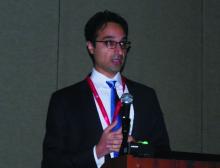HONOLULU – The well-documented link between higher procedure volumes and better procedure efficacy also applies to endovascular thrombectomy for acute ischemic stroke.
in analysis of data from two different U.S. sources: the National Inpatient Sample (NIS) and the state of Florida, Sunil A. Sheth, MD, said at the International Stroke Conference sponsored by the American Heart Association.
The finding raises questions about how to best triage patients with an acute ischemic stroke, suggesting that, in at least some situations, patients might be better served being taken to a higher-volume center even if it’s not the closest, noted Dr. Sheth, The results also suggest that the findings in the trials proving the value of EST run primarily at large, tertiary care, referral centers might not be generalizable to all centers that start an endovascular program.
The study looked at data collected during 2006-2016 in Florida and during 2012-2016 in the NIS, and found that in both databases the rate of EST procedures performed showed steadily increasing use over time, with a sharp increase in the number of centers performing EST in 2015. Each of the two data sets also showed that better discharge outcomes occurred in patients treated at centers with the highest procedural volumes.
In the nationwide NIS data, for every 10 additional patients a center treated with EST annually, the incidence of a “good” hospital-discharge outcome (defined as either discharge home or to an acute rehabilitation hospital) rose by 30%, compared with lower-volume centers in a multivariate regression analysis, a statistically significant relationship, said Dr. Sheth, a neurologist at the University of Texas, Houston. This volume-outcome relationship held fairly constant through volumes up to about 50 EST cases annually. “The more the better,” he observed.
“The data suggest that EST outcomes are not always the same,” but right now most emergency medical service systems do not take EST case volume into account when deciding where to take an acute stroke patient, Dr. Sheth said in an interview. But he cautioned against an oversimplified focus on just EST case volume.
A link between volume and better outcomes “is easy to understand and not surprising. We see this relationship for a variety of procedures. The data suggest we need to consider procedure volumes. But volume is only part of makes for good outcomes; it’s not the only factor,” he stressed.
Dr. Sheth and his associates used data collected by the Florida Agency for Health Care Administration on 3,890 acute ischemic stroke patients treated with EST at 56 Florida hospitals and on 42,505 such patients in the NIS database treated at 2,260 U.S. hospitals. During the 11-year period for Florida data collection, the number of centers performing EST in the state rose steadily at an average rate of about four new centers per year. Although the number of EST procedures done also rose sharply, in general over time a higher percentage of patients underwent treatment at lower-volume centers. Similar patterns existed in the national data. The Florida data showed a statistically significant 10% improvement in good discharge outcomes for every 10 additional EST patients a center treated a year, consistent with the NIS data.
Concurrently with Dr. Sheth’s report, the results also appeared in an article published online (Stroke. 2019 Feb 6. doi: 10.1161/STROKEAHA.118.023967).
Dr. Sheth reported no disclosures.
SOURCE: Sheth SA et al. ISC 2019, Abstract 002.



